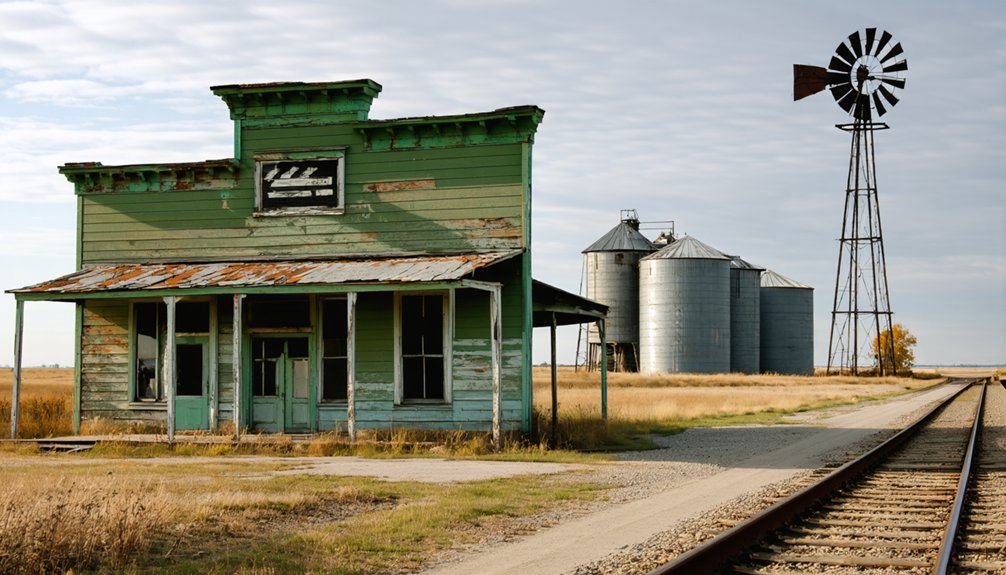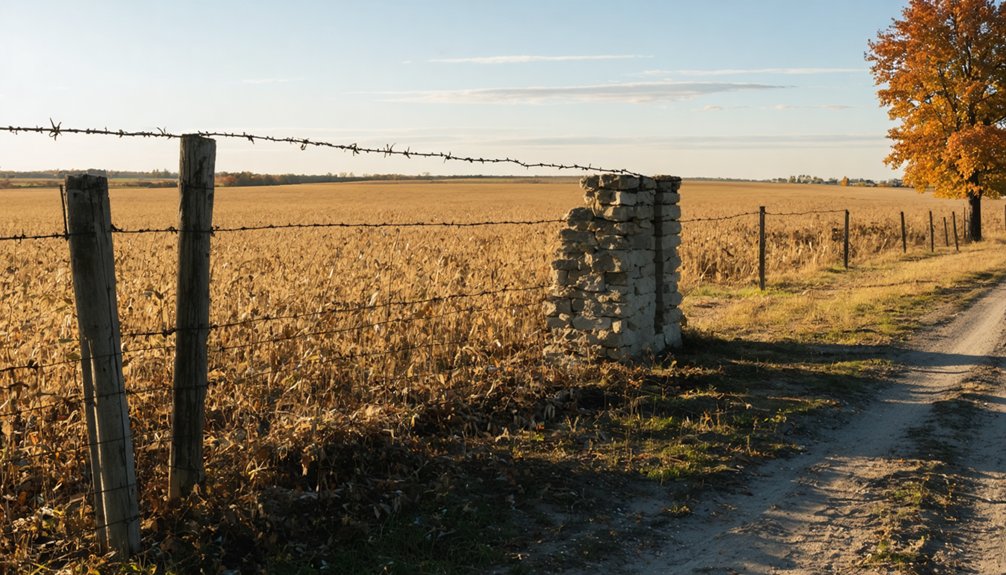You’ll find Challacombe nestled in Macoupin County, Illinois, where Nicholas Challacombe established a thriving agricultural community in 1887 near the St. Louis, Chicago, and St. Paul Railroad line. His 700-acre farming operation and strategic railroad station transformed this prairie settlement into a crucial grain transport hub. However, by 1909, the railroad’s abandonment led to the town’s decline. Today, this ghost town’s story reflects the broader changes that reshaped rural Illinois communities.
Key Takeaways
- Challacombe was established in 1887 in Chesterfield Township, Macoupin County, Illinois, around “the Mound” near major railroad lines.
- Nicholas Challacombe, an English immigrant, developed the settlement through his 700-acre farming operation and railroad station establishment.
- The town flourished briefly as a railway hub for grain transport, connecting local farmers to major markets in Chicago and St. Louis.
- By 1909, the railroad line was abandoned, leading to the town’s economic decline and eventual transformation into a ghost town.
- The Great Depression eliminated any chance of reviving the rail line, cementing Challacombe’s fate as an abandoned settlement.
The Rise of a Prairie Settlement
While many prairie settlements emerged along railroad lines in late 19th century Illinois, Challacombe’s story began on June 3, 1887, when it was officially established in Section 20 of Chesterfield Township, Macoupin County.
The settlement geography centered around a natural elevation known as “the Mound,” alongside the St. Louis, Chicago, and St. Paul Railroad line.
You’ll find that community dynamics formed around a small group of pioneering families, with Nicholas Challacombe emerging as a key figure. Nicholas Challacombe arrived from Devonshire, England in 1840.
The settlement’s agricultural foundation thrived through the railroad’s connectivity, enabling farmers to transport their grain and livestock to broader markets.
Despite its modest size, Challacombe represented the quintessential prairie settlement, where freedom and opportunity drew settlers seeking to establish their own destiny through farming and commerce.
Nicholas Challacombe’s Vision
Nicholas Challacombe’s vision for the Illinois settlement began with his family’s pioneering efforts to transform untamed prairie into productive farmland in 1840.
Your journey through the area’s history reveals how Challacombe’s successful farming practices led to the establishment of a railroad station bearing his name, though the settlement would later be absorbed into nearby Medora.
Born in Devonshire, England, Nicholas Challacombe brought his agricultural expertise to Illinois where he would establish his new home.
His extensive experience in agriculture resulted in expanding his initial 400-acre land purchase into a prosperous 700-acre farming operation.
Your journey through the area’s history reveals how Challacombe’s successful farming practices led to the establishment of a railroad station bearing his name, though the settlement would later be absorbed into nearby Medora.
Early Settlement Challenges
After emigrating from Devonshire, England in 1833, the ambitious Nicholas Challacombe first settled among fellow English immigrants in Genesee County, New York, before setting his sights on Illinois’s frontier opportunities.
By 1840, he’d moved to Macoupin County, Illinois, where he faced significant settlement difficulties establishing his homestead in Section 21, known as “the Mound.” Agricultural hardships included transforming wilderness into farmland while dealing with challenging soil conditions and limited infrastructure. The family’s determination paid off as Nicholas’s son would later own and manage 240 productive acres.
- Isolation and poor transportation options hindered early development until the railroad’s arrival in 1887.
- Harsh frontier conditions required adapting to wilderness settings and potential regional instability.
- Limited roads and communication networks complicated trade and community connections.
Despite these obstacles, Challacombe developed substantial landholdings and established a lasting agricultural legacy in the region.
Farming Legacy and Impact
Through innovative farming practices and strategic land management, the Challacombe family established a remarkable agricultural legacy in Macoupin County during the mid-1800s.
After emigrating from Devonshire, England in 1840, Nicholas Challacombe implemented advanced farming techniques that transformed the local agricultural landscape. You’ll find his influence reflected in the early adoption of crop diversification and stock-raising methods that enhanced both productivity and agricultural sustainability.
The Challacombes’ commitment to environmental stewardship set new standards for land management in the region. Their farm expansion created jobs, strengthened the local economy, and introduced English agricultural traditions to Illinois soil. Following practices similar to successful farmers like Judson P. Enslow, who began as a farmhand and grew to own 165 acres in Shaws Point township, the Challacombes demonstrated how determination could lead to agricultural prosperity.
They didn’t just build a successful farm – they fostered community development through their agricultural leadership and economic investments, leaving an enduring impact on Macoupin County’s history.
Railroad Town Development
The establishment of Challacombe, Illinois on June 3, 1887, marked a pivotal moment in Macoupin County’s development, strategically positioned along the St. Louis, Chicago, and St. Paul Railroad Line.
You’ll find that railroad expansion transformed this Section 20 plot in Chesterfield Township into a bustling transportation hub, creating new opportunities for economic development and growth. The town’s success was bolstered by the Chicago & Alton which had already established routes through the county by 1864. The area’s rich deposits of limestone and marble made it an attractive location for industrial development.
- The Chicago, Springfield and St. Louis Railway connected Challacombe to major cities, establishing crucial trade routes.
- Strategic railroad placement helped develop local infrastructure and boosted regional commerce.
- The town’s position along multiple rail lines made it an important transit point for goods and passengers.
Today, while the town has merged with Medora, you can still trace its railroad heritage through remaining structures and the historic Challacombe Road, proof of a time when rail transportation shaped America’s frontier communities.
Railroad’s Influence on Growth
The St. Louis, Chicago, and St. Paul Railroad’s construction in 1887 directly sparked Challacombe’s establishment, drawing settlers to this strategic location in Macoupin County.
You’ll find that the railroad enabled local farmers to efficiently ship grain and livestock to distant markets, with the town’s grain silos serving as vital storage points along the line. Modern aerial maps show where these important railway routes once connected the town to regional commerce.
The eventual abandonment of the rail line proved fatal for Challacombe’s future, leading to its disbandment in 1909 as economic opportunities and residents relocated to better-connected towns. Like other settlements in The Sucker State, Challacombe’s fate was tied closely to its transportation infrastructure.
Rail Construction Spurs Settlement
During the construction of the St Louis, Chicago, and St Paul Railroad Line, Challacombe emerged as a promising settlement in Section 20 of Chesterfield Township, Macoupin County.
You’ll find that railroad expansion played a vital role in transforming this farming community into a hub of activity. Similar to how the Chicago Burlington and Quincy Railroad transformed Buda, Illinois in 1854, the town’s economic viability depended heavily on the railway’s presence, which brought essential services and new opportunities to the area.
- Roads and railroad stops formed the backbone of the town’s infrastructure
- Nicholas Challacombe, a prominent farmer, helped establish the early settlement
- The railway created jobs in construction, maintenance, and operations
The railroad’s arrival attracted businesses and settlers, making Challacombe a prime example of how rail construction could spark the birth and growth of a new community.
Grain Transport Drives Economy
Building upon the rail line’s establishment, Challacombe’s economy flourished through its grain transport capabilities.
You’d find strategic grain silos dotting the landscape, allowing farmers to store their harvests until ideal market conditions emerged. The St. Louis, Chicago, and St. Paul Railroad transformed the region’s transport efficiency, replacing costly horse-and-wagon methods with reliable rail freight.
Market accessibility exploded as the railroad connected local farmers to regional and national buyers, dramatically reducing shipping costs and eliminating seasonal river navigation constraints.
You could see year-round grain movements that weren’t possible before, stabilizing the supply chain and encouraging larger-scale cultivation.
Even after Challacombe’s eventual decline, the grain infrastructure remained, proof of the lasting economic impact of the railroad-driven agricultural boom that defined the town’s 1887-1909 heyday.
Line Abandonment Seals Fate
While Challacombe’s initial success hinged entirely on its railroad connection, abandonment of the St. Louis, Chicago, and St. Paul Railroad Line by 1909 sealed the town’s fate.
You’ll see how this transportation evolution transformed the region, as automobiles and trucks began dominating freight movement. The economic restructuring that followed left Challacombe isolated and unable to sustain itself.
- Railroad buildings were quickly boarded up and abandoned after operations ceased
- The Great Depression eliminated any chance of reviving the rail line
- Completion of Illinois Route 111 redirected transport away from rail-dependent towns
Without rail access to markets, Challacombe’s commercial viability disappeared. The town’s dissolution was complete by January 19, 1909, marking the end of its brief 22-year existence as a railroad community.
Daily Life in Early Challacombe
Life in early Challacombe centered around three core activities: farming, stock-raising, and railroad-related commerce. You’d find residents working their land from sunup to sundown, following seasonal routines that dictated when to plant, tend, and harvest crops.
The Challacombes, led by Nicholas, set the tone for the community’s agricultural focus.
Community interactions revolved around shared farm work and the railroad station, where you might catch neighbors trading goods or awaiting shipments. Without local stores or services, you’d need to be self-sufficient or travel to nearby towns for necessities.
Your daily schedule would follow nature’s clock – caring for livestock at dawn, tending fields during daylight, and handling household tasks between farm duties. Most families produced their own food and basic goods, trading with neighbors for items they couldn’t make themselves.
Agricultural Legacy and Commerce

The agricultural foundation of Challacombe rested firmly on Nicholas Challacombe’s arrival from Devonshire, England in 1840. His settlement at “the Mound” launched agricultural innovations that would shape the region’s farming legacy.
Under John William Challacombe’s management, the family’s holdings expanded to 240 acres of productive land, showcasing community resilience through diversified farming practices.
- Breaking new ground with animal-powered plows yielded 25-30 bushels of wheat and 40-60 bushels of oats per acre
- Mixed farming operations included a 20-acre orchard and extensive livestock management
- The arrival of the St. Louis, Chicago, and St. Paul Railroad in 1887 connected local farmers to broader markets
You’ll find the Challacombe’s agricultural success stemmed from their balanced approach to crop rotation, livestock integration, and strategic use of railroad transportation for commerce.
The Path to Disbandment
Despite its promising agricultural beginnings, Challacombe’s fortunes began to wane as the St. Louis, Chicago, and St. Paul Railroad Line lost its economic relevance.
You’d have witnessed the community’s resilience tested as younger residents left for better opportunities, while limited employment beyond farming and railroad services hindered economic adaptation. The town’s lack of incorporation restricted access to government support, making it difficult to maintain essential services or attract new investment.
As agricultural practices modernized and farms consolidated, the need for local grain facilities diminished. Farmers began bypassing Challacombe for larger market centers, accelerating the town’s decline.
By January 19, 1909, these compounding challenges led to official disbandment, with the town being absorbed into neighboring Medora.
Today, only an intersection, one house, and two grain silos remain.
What Remains Today

While many ghost towns retain visible remnants of their past, modern-day Challacombe in Macoupin County offers few traces of its former existence. If you visit the site today, you’ll find a rural landscape where abandoned structures have long since disappeared, giving way to rolling agricultural fields and natural vegetation.
Local wildlife has reclaimed the area, making it indistinguishable from the surrounding Illinois countryside.
- The original town site has no remaining buildings or foundations, leaving visitors with little evidence of its past settlement.
- Agricultural development and natural processes have transformed the landscape, erasing most physical signs of human habitation.
- Remote location and lack of infrastructure make the area difficult to access, with no designated historical markers or preserved sites.
Historical Impact on Macoupin County
Beyond its vanished physical presence, Challacombe’s deeper significance emerges through its role in shaping Macoupin County’s development during the late 19th century.
You’ll find that this small settlement exemplified community resilience through its strategic position along the St. Louis, Chicago, and St. Paul Railroad, which connected local farmers to major markets.
The town’s economic evolution mirrored broader changes in rural Illinois, from Nicholas Challacombe’s initial agricultural ventures to the community’s role in facilitating regional trade.
As one of many railroad towns that briefly flourished in Macoupin County, Challacombe’s story reflects the transformative impact of transportation networks on farming communities and the continuous adaptation required for survival in America’s rapidly changing agricultural landscape.
Frequently Asked Questions
Were There Any Notable Crimes or Incidents in Challacombe’s History?
You won’t find any documented crimes, unsolved mysteries, or ghostly encounters here – historical records show this short-lived farming town was remarkably peaceful during its brief 22-year existence from 1887-1909.
What Was the Highest Population Challacombe Ever Reached?
You won’t find exact Challacombe demographics in historical records, but since it was classified below village status, its peak population must have remained under 200 residents before its population decline into abandonment.
Did Any Famous People Ever Visit or Live in Challacombe?
You won’t find any famous visitors or local legends in historical records. The only notable residents were the Challacombe family themselves, particularly Nicholas Challacombe and his farming operations.
Were There Any Schools or Churches Established in Challacombe?
You might think a railroad town would have the basics, but there’s no documented school history or church significance in Challacombe. Local residents likely traveled to nearby Medora for these services.
What Happened to the Original Railroad Tracks Through Challacombe?
You’ll find those railroad tracks were dismantled and abandoned, reflecting the broader railroad history of rural Illinois. After years of track deterioration, the land was converted to farmland and rural development.
References
- https://drloihjournal.blogspot.com/2017/11/lost-towns-of-illinois-challacombe.html
- https://drloihjournal.blogspot.com/2022/05/lost-towns-of-illinois-challacombe-illinois.html
- https://www.youtube.com/watch?v=93k0qtvzkn4
- https://pastmaps.com/explore/us/illinois/macoupin-county/challacombe/hiking-exploration
- http://livinghistoryofillinois.com/pdf_files/History of Macoupin County
- https://pastmaps.com/explore/us/illinois/macoupin-county/challacombe/metal-detecting
- https://sangamoncountyhistory.org/wp/14696/
- https://www.ghosttowns.com/states/il/challacombe.html
- https://en.wikipedia.org/wiki/List_of_ghost_towns_in_Illinois
- http://livinghistoryofillinois.com/pdf_files/Challacombe



